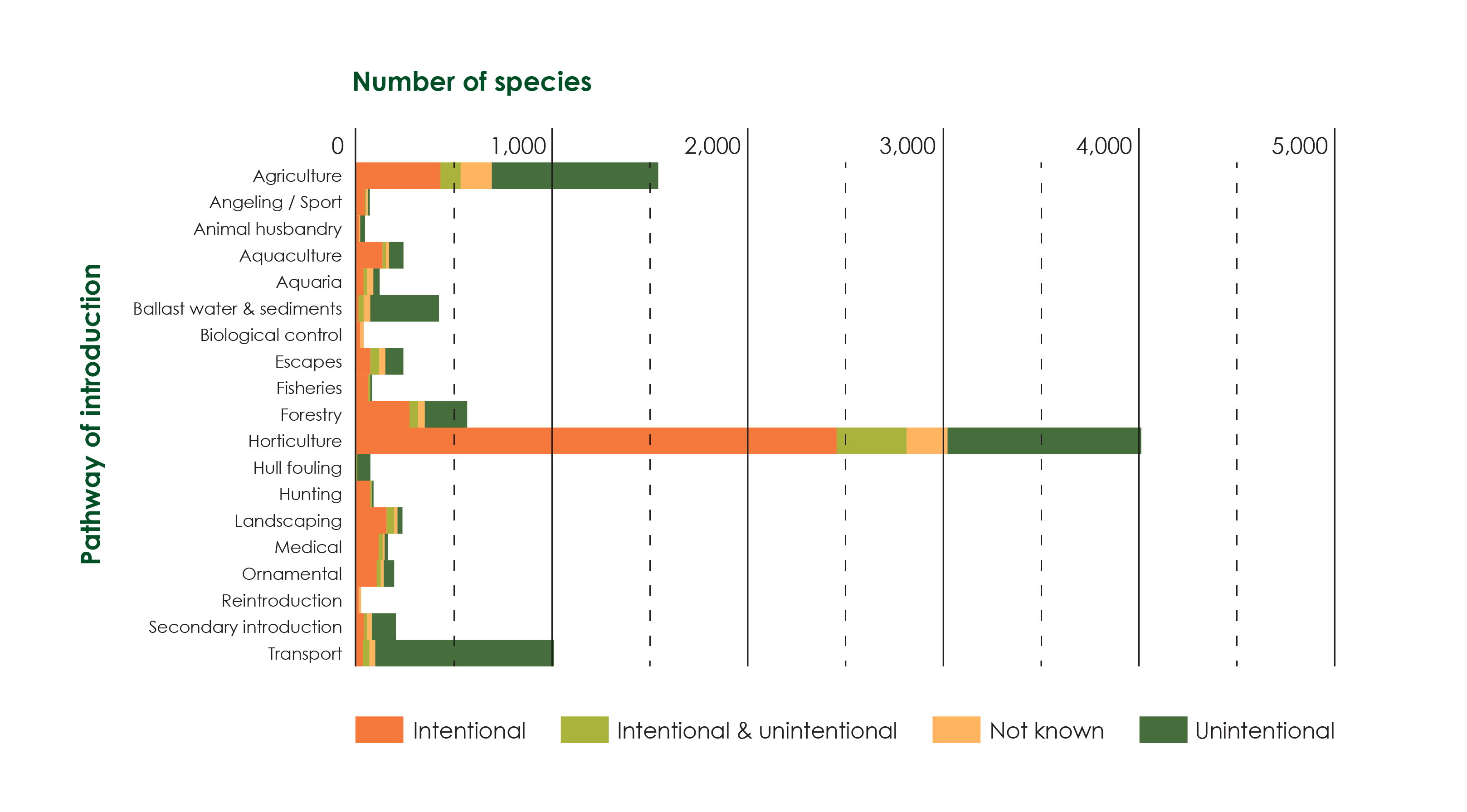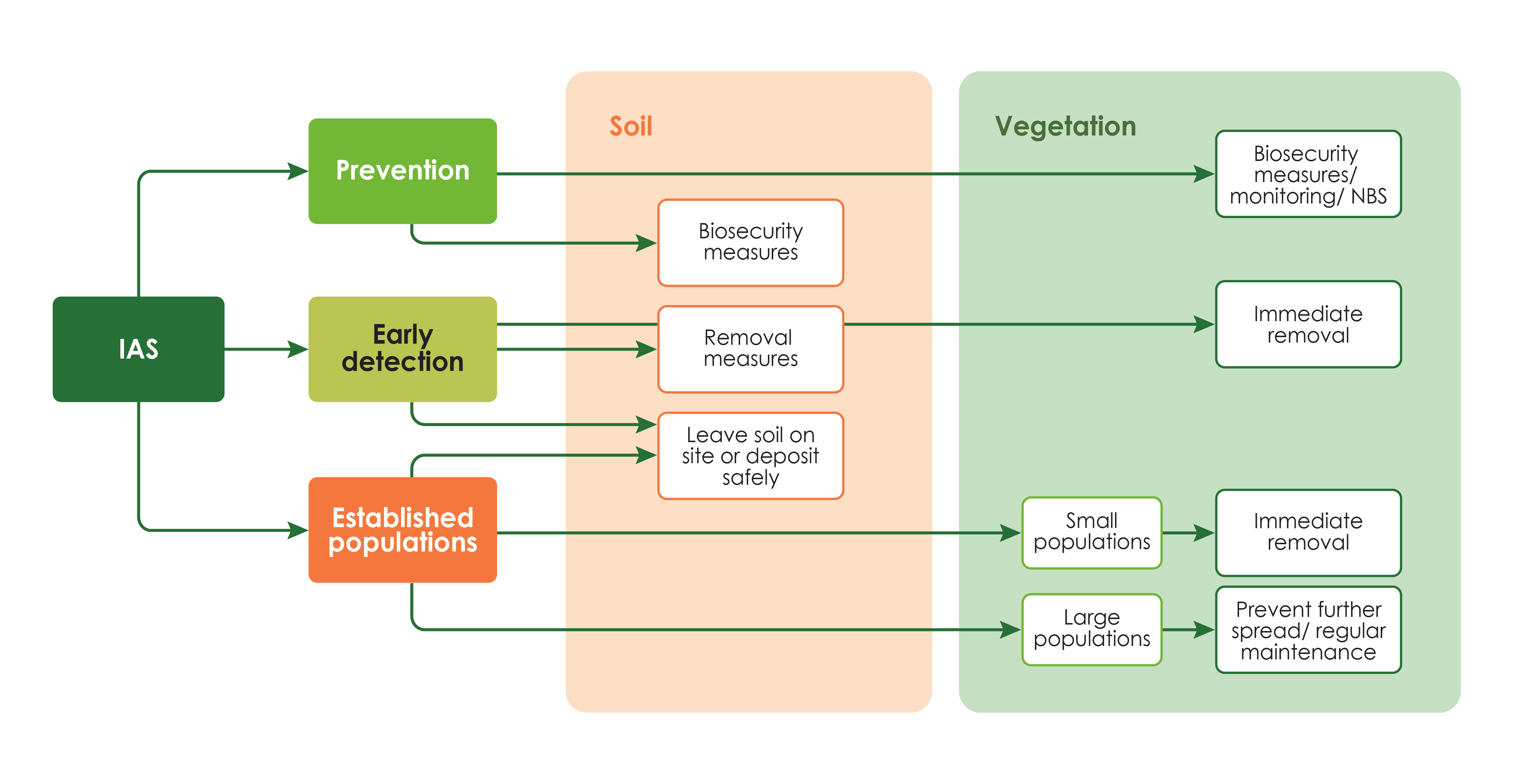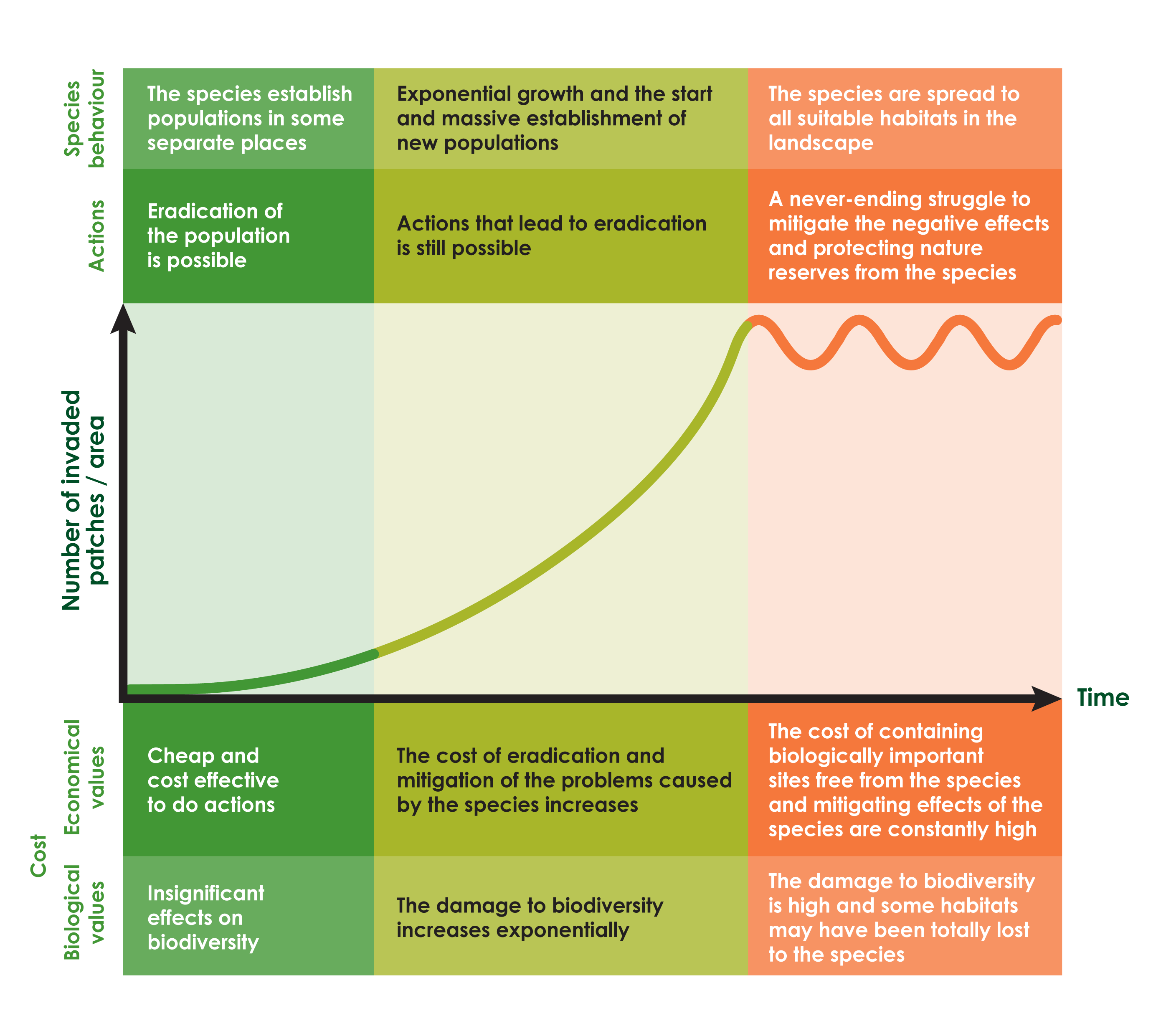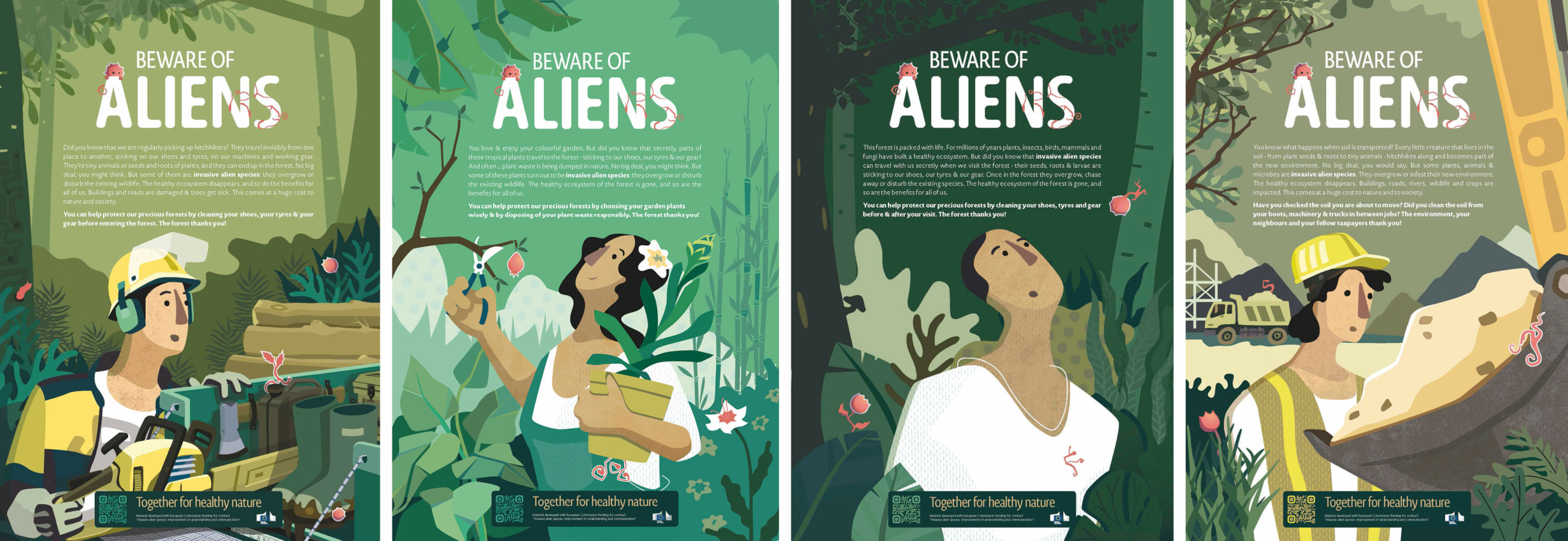RATIONALE. Methods for tackling Invasive Alien Species (IAS)
To control Invasive Alien Species (IAS) and to prevent their spread is a huge challenge for parties responsible. A variety of measurements against IAS are available but often have to be adapted to target species and local conditions. Hence, methods are constantly under development and their application needs a certain degree of flexibility in maintenance plans (CEDR 2020). The first step is always the identification of an occurrence of IAS and potential pathways (or vectors) of introduction. Personnel should be trained in species identification and the use of free apps or specific websites (EPPO; CABI) is also recommended (e.g., InvasivApp, KORINA, PlantNet). Adequate control measures are chosen considering specific IAS and local conditions. All processes and measures are monitored and documented, ideally for some time after complete removal of IAS. Documentation is essential as long-term data and studies are currently rare. Generally, there is clearly a need for further research in this area.
IAS prevention is regarded as the best practice to be applied. Information and guidelines which aim to increase biodiversity whilst preventing the spread of IAS are available in Ministerium für Verkehr BW 2016; Bromley et al. 2019; Bayerisches StMB 2020. In addition, the engagement of all stakeholders is key to successfully prevent further spread of IAS. An increase in awareness, perception, further collaborative research, work across borders and prioritization of common goals is essential in addition to any measures taken. The important role of stakeholders has also been recognised by policy makers in the Convention on Biological Diversity, the European Strategy on Invasive Alien Species and the EU regulation (Genovesi and Shine 2003; Shackleton et al. 2019; Regulation (EU) 2014).
A lot of information about IAS management is found only in grey literature which is usually published in the native language of stakeholders involved in IAS control. There is generally a lack of published data on the evaluation and effectiveness of methods and especially at the international level. The information in this chapter has been adapted from pilot studies developed in specific site conditions and research project reports by the Federal Highway Research Institute (BASt, 2019 Germany; unpublished Project FE 02.0429/2019/LRB). It has been completed with knowledge and experience from maintenance depots (BASt, 2022) and results from long term observation of road verges (Molder et al. 2022). Plants that are of particular concern to managing road verges and waterway embankments have been investigated in more detail in individual studies (BASt, 2020; Nielsen et al. 2005; Walser 2019) as well as in vegetation management within different transport sectors such as railways (UIC, 2021). Vast damage is caused by IAS each year (European Commission, 2023c; Haubrock et al. 2021) and is likely to increase with a warmer climate, further land use change and lack of action. Hence, it is worth looking into early warning systems, acting immediately on any initial occurrence of IAS and establishing reliable monitoring programmes.
Invasive Alien Species (IAS) are plant and animal species which are not native to the area concerned -in this case Europe- but which have been intentionally or unintentionally introduced through human activities. They negatively impact biodiversity, human health or the economy and their spread is expected to increase due to impacts of climate change. They can establish themselves quickly and very easily in suitable habitats. Verges and embankment along roads, railway or waterways, and powerlines right of way (ROW) can provide ideal habitats since there are often open areas which have been disturbed. The unintentional transport of propagules via airflow, attachment to vehicles or through maintenance activities further facilitates the introduction and spread of IAS along transport infrastructure.
IAS are found in all types of transport infrastructure, and their spread can only be prevented by addressing pathways of introduction (Figure 5.8.1). Although methods of dispersal for IAS, either intentionally or unintentionally, are similar for each mode of transport, the implementation of mitigation measures to prevent and reduce their spread may need to be specific to different transport modes. Increased and more extensive maintenance efforts and possibly simultaneous disruptions to transport traffic are important factors that decision makers have to consider when selecting measures to prevent and control the spread of IAS.

The aims for successful IAS management must be:
- for areas without IAS: to prevent introductions (i.e., biosecurity measures, regular monitoring and early awareness)
- for initial populations: immediate eradication measures
- for small IAS populations: eradication (i.e., maintenance and control measures)
- for large IAS populations: primarily to prevent further spread; or immediate actions for eradication in sensitive areas (e.g., adjacent to nature protected areas) or sites where they represent a safety risk.
The early implementation of IAS management is very important as maintenance efforts and costs increase considerably over time (Figure 5.8.2). The costs for increased maintenance efforts related to IAS are significant. However, not only the transport sector faces problems caused by the spread of IAS across Europe. Crop losses in agriculture are frequently caused by IAS and in the health care sector, new diseases due to IAS are being registered. Hence, it is important to develop strategies to stop IAS spread.
Main goal for IAS management should always be prevention (Figure 5.8.3). Once IAS occur different stages that may require different actions should be identified. In the very early stages, IAS must be immediately removed. Similarly, very small populations should be immediately removed. Larger, well established populations should mainly be prevented from spreading further as complete removal of such populations is often difficult. However, this requires frequent mitigation measurements and in the long term could make the problem worse. Measures for removal and for the prevention of introduction or further spread may require treating either vegetation or the soil. Because the removal of IAS from soil is extremely difficult and expensive, prevention is essential.

Interconnection points for different transport modes, such as ports or areas where road and railway transport come together are often hotspots for the introduction of IAS. They should be carefully surveyed.
IAS are moving not only via transport infrastructure but also through the actions of the general public, trade and travel sector. It is important to inform people about the topic and make them aware about the possible outcomes of their actions. The EU is taking this topic very seriously as shown in legislation and actions. Several countries have implemented action plans (Table 5.7) and increased efforts to bundle measurements and information (Figure 5.8.4).
Table 5.7 – Examples of action plans for IAS control developed by European countries on demand of the European Commission.
| Country | Action plan | Link |
| Austria | YES | Aktionsplan für die Pfade invasiver gebietsfremder Arten in Österreich (Environment Agency Austria, 2023) https://www.neobiota-austria.at/fileadmin/inhalte/neobiota/pdf/pfad-aktionsplan_2022-05-20_bf.pdf |
| Belgium | YES | Plan d’action national sur les voies prioritaires d’introduction et de propagation non intentionnelles d’espèces exotiques envahissantes de la liste de l’Union en Belgique: résultats de la consultation publique (The Federal Public Service (FPS) Health, Food Chain Safety and Environment, 2022) https://www.health.belgium.be/fr/consultation-publique-sur-le-projet-de-plan-daction-national-sur-les-voies-prioritaires |
| Croatia | Integrated in Nature conservation plan | The Nature Protection Strategy and Action Plan of the Republic of Croatia for the period 2017-2025 (Parliament of the Republic of Croatia, 2017) https://www.cbd.int/doc/world/hr/hr-nbsap-v3-en.pdf |
| Czech Republic | Specific information provided | Analýza způsobů šíření invazních nepůvodních druhů s významným dopadem na Unii a dalších prioritních invazních druhů České republiky (Pergl et al., 2022) https://www.mzp.cz/C1257458002F0DC7/cz/nepuvodni_invazivni_druhy_legislativa/$FILE/ODOIMP-analyza_sireni-20220406.pdf Metodiky, příručky, standardy (Nature and Landscape Protection Agency of the Czech Republic, 2023) https://invaznidruhy.nature.cz/metodiky-prirucky |
| Denmark | YES | Action plan against invasive species (The Danish Environmental Protection Agency, 2017) https://eng.mst.dk/nature/invasive-alien-species |
| Estonia | Integrated in Nature conservation act | Alien species (Republic of Estonia Environmental Board, 2021) https://keskkonnaamet.ee/en/wildlife-nature-protection/alien-species |
| Finland | Management plan | Management Plan to prevent Invasive Alien Species – consolidated plan (Ministry of Agriculture and Forestry, 2022) https://mmm.fi/documents/1410837/1894125/EN_Yhdistetty_Hallintasuunnitelma_8.6.2022.pdf/39ea9513-94fb-5ec6-e39c-6e821e8f375a/EN_Yhdistetty_Hallintasuunnitelma_8.6.2022.pdf?t=1654673488403 Invasive Alien Species (Ministry of Agriculture and Forestry, 2023) https://mmm.fi/en/nature-and-climate/alien-species |
| France | YES | Stratégie nationale relative aux espèces exotiques envahissantes (Ministère De L’environnement, De L’énergie Et De La Mer, En Charge Des Relations Internationales Sur Le Climat, 2017) https://inpn.mnhn.fr/actualites/lire/7681/parution-de-la-strategie-nationale-relative-aux-especes-exotiques-envahissantes |
| Germany | YES | Erster Aktionsplan zu invasiven Arten (BMUV, 2021) https://www.bmuv.de/download/erster-aktionsplan-gemaess-artikel-13-der-verordnung-eu-nummer-1143-2014-des-europaeischen-parlaments-und-des-rates-vom-22-oktober-2014 |
| Ireland | YES | Ireland’s Pathway Action Plans Angling (Department of Housing, Local Government and Heritage, 2022) https://invasives.ie/app/uploads/2022/07/Irelands_IAS_Angling-PathwayActionPlan_2022-2027-FINAL.pdf Recreational boating and watercraft (Department of Housing, Local Government and Gaeltacht, 2022) https://invasives.ie/app/uploads/2022/07/Irelands_IAS_RecreationalBoatingAndWatercraft-PathwayActionPlan_2022-2027-FINAL.pdf Movement of soil and stone (National Parks and Wildlife Services; Department of Housing, Local Government and Heritage,2023) https://invasives.ie/app/uploads/2023/06/IrelandsInvasiveAlienSpecies-SoilAndStone-PathwayActionPlan-2023-2027_FINAL.pdf Actions on Invasives (National Biodiversity Data Centre, 2023) https://actionsoninvasives.biodiversityireland.ie/ Ireland’s invasive species website (National Biodiversity Data Centre, 2023) https://invasives.ie/ |
| Italy | YES | The Italian Legislative Decree on invasive species has been published: bans, controls, eradication and management (GU Serie Generale, 2018) https://www.isprambiente.gov.it/en/archive/news-and-other-events/ispra-news/year-2018/february/the-italian-legislative-decree-on-invasive-species-has-been-published-bans-controls-eradication-and-management |
| Malta | YES | National Strategy for Preventing and Mitigating the Impact of Invasive Alien Species (IAS) in the Maltese Islands (ERA, 2020) https://era.org.mt/national-strategy-for-preventing-and-mitigating-the-impact-of-invasive-alien-species-ias-in-the-maltese-islands/ |
| Netherlands | Specific information provided | Onderbouwing strategie Unielijstsoorten (Nederlands Voedsel- en Warenautoriteit, 2016) https://www.nvwa.nl/binaries/nvwa/documenten/dier/dieren-in-de-natuur/exoten/publicaties/onderbouwing-strategie-unielijstsoorten/Onderbouwing+strategie+Unielijstsoorten.pdf Kennisnetwerk Invasieve Exoten (Kennisnetwerk Invasieve Exoten, 2023) https://www.invasieve-exoten.info/nl/invasieve-exoten.htm |
| Spain | YES | Plan de acción sobre las vías de introducción y propagación de las especies exóticas invasoras en España (Ministerio para la Transición Ecológica y el Reto Demográfico, 2021) https://www.miteco.gob.es/es/biodiversidad/temas/conservacion-de-especies/planviasdeentradadeeeilimpio12julio2021_tcm30-529319.pdf |
| Sweden | Guidelines available | The Ecological and Cultural Heritage Standards (Trafikverket, 2019) https://bransch.trafikverket.se/contentassets/89b7002c5aa1451abf1fc86f47126684/tdok-2015-0323-the-ecological-and-cultural-heritage-standards.pdf |

